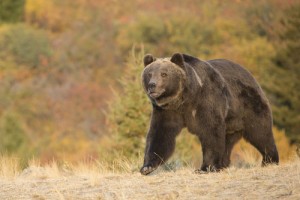
(Ursus arctos horribilis)
Description: Equipped with massive shoulders and muscular necks, females weigh between 300 – 450lbs., with males averaging 400 – 800lbs. Largest males can weigh over 1,000lbs. Shoulder height is approximately 36 inches; body length is 72 – 96 inches. Run up to 35mph and have long, non-retractable claws for digging. Brown – yellow – cinnamon fur with distinguishable back hump (black bears do not have hump).
Diet: Largely omnivores, 70 – 80% of diet is vegetation, including roots, stems, leaves, flowers, nuts and berries. Adept at digging up insects, squirrel caches, marmot dens and mice. Also prey on larger mammals, particularly young elk, deer and moose. White-bark pine historically invaluable source of nutrition; it is severely declining however due to climate change. Other traditional food losses are in decline to.
Habitat: Once prominent along short-grass prairie of West; now largely limited to ridges, mountains, and forested landscapes of Northern Rockies. Require large tracts of protected landscapes with minimal road density and human disturbance. Denning usually begins begins October/November and hibernate throughout winter do not eat, drink, urinate or defecate during that time).
Range: Five designated recovery zones: Greater-Yellowstone, Northern Continental Divide, Cabinet-Yaak, Selkirks, and Bitterroots; latter includes Clearwater Basin and upper portions of St. Joe Drainage.
Reproduction: Produce cubs every other year or every three years; do not come into sexual maturity until seven years of age. Typically mate June/July with 1 – 4 cubs born in January – March. Cubs emerge from den in April/May with mother.
Threats: Road building, logging, habitat loss/fragmentation, poaching, and loss of traditional foods. Lack of connectivity (bears moving/breeding with bears in other recovery zones) is major threat too.
Legal Status: Remain listed as threatened under Endangered Species Act despite wrongful attempts of federal government.
Miscellaneous: In 2007, 500 – 600lb. male grizzly bear shot/killed in Kelly Creek drainage on Clearwater National Forest by client of local outfitter. DNA results indicate bear dispersed from Selkirk Mountains in North Idaho. Was first confirmed grizzly bear in North Central Idaho in approximately sixty years. In 2018, male grizzly appeared in Bitterroot Valley of Montana but was relocated north of I-90.
Learn about grizzly bear recovery efforts.
Return to main Native Species page.